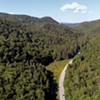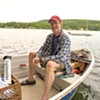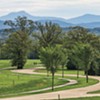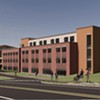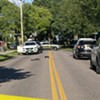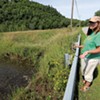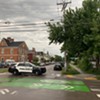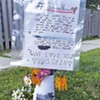Published September 7, 2022 at 10:00 a.m.
'Breathtaking' Photo
I greatly appreciate the depth and breadth of Seven Days' Vermont coverage ["On the Road," August 24]. I did want to comment on Paula Routly's picture of asbestos tailings on Belvidere Mountain. Would it be wrong to say "breathtaking"?
Richard Guttman
Kirkland, Québec
Asbestos Mountain
[Re "On the Road," August 24]: Belvidere Mountain and the largest of the asbestos slag piles are visible along Route 100 from about halfway between Stowe and Morrisville. Last I heard, plans were still pending on how this toxic waste would be cleaned up.
Bryan Nepveu
Morrisville
Swap Talk
Rachel Hellman's article on barter is spot-on ["Trade Wins," August 17]. The story she tells matches the findings from a recent research project on barter that my colleague Henry Neuman and I carried out. Interviews with Vermonters revealed that neighbors trade items and favors in all sorts of arrangements. Many offer things that they possess in far greater abundance than money, such as extra eggs from their chickens or seasonal surpluses such as apples. Strong relationships are not just a by-product; interviewees said they choose moneyless exchange because it builds communities of trust and care.
In fact, much of what Vermonters call "barter" works more like gift exchange. While economists narrowly define barter as simultaneously swapping entities of equal value, we find that barter exists on a transaction-to-gift spectrum. At one extreme, one-off traders simply strike a deal that feels fair to both parties. At the other pole, friends maintain ongoing relations of reciprocal gift giving that never even out, often without even trying to keep track.
But why do people refer to that as "barter"? Our best guess, based on our interviews and evidence from elsewhere, is that pretending to trade feels comfortable to folks brought up in a cutthroat capitalist world, even when we are actually just practicing neighborly solidarity. Historically, however, mutual aid is the norm. Prior to urbanization and Venmo, humans distributed resources through gifts; trade was reserved for strangers and enemies. There was no era of bartering before money arose. Barter, to the extent it exists, is a modern anomaly.
Sam Bliss
Burlington
Merci, Olmsted
I want to thank you and give applause for the article on Frederick Law Olmsted ["Room to Roam," August 17]. His work with the U.S. Sanitary Commission during the Civil War with one Walt Whitman was groundbreaking and extraordinary and may have marked a turning point.
His impact on my own life has also been extraordinary. North of the border, his designs of Parc du Mont-Royal, Parc Salle Wilfrid Laurier and, most importantly, Parc La Fontaine had an outstanding and decades-long importance to me.
My love of Montréal began the year it hosted Expo '67. I made eight trips that summer and next year returned and met someone who would be a lifelong friend. On a park bench across the pond from the performance stage, I found Jocelyne. He was just learning English, and I, French. He played guitar, and I sang. Two years later, he and three other performers played that place in the park — over and over and over.
Now, 54 years later, Josh, the three others and I continue to make music in my beloved park. Seven Days is the offspring of my adored Vermont Vanguard Press and Montréal Mirror. Thank you so much for all you have given me and continue to do.
Jeffrey Waite
Shelburne
Gassing Down
Every time I hear a quote from the methane merchants, aka Vermont Gas Systems, I think of the quote from Upton Sinclair: "It is difficult to get a man to understand something when his salary depends upon his not understanding it." In this particular situation, it is the profits of huge corporations that depend on the ratepayers and regulators not paying attention to the big picture.
["Hot Air?" July 27] illuminates the snow job that has been forced upon our state. I have been baffled by the "gas math" that VGS has used from the inception of the Addison Natural Gas Project to justify its build-out. At times, it has seemed that the company pulls numbers out of where the sun don't shine. This company has demonstrated that it will promise anything to get what it wants and then ask for forgiveness when it doesn't deliver.
Ten years ago, we argued that hooking up Addison County to the pipeline system was not only bad for the environment but also unnecessary, because the cold-climate heat pump was making its way into mainstream America. The company's lawyers, and Vermont's regulatory system, adamantly argued against heat pumps, and now the company is actually selling cold-climate heat pumps to its customers.
What we need from VGS is a commitment to permanently scrap all plans of expansion or increased capacity and instead commit to a 10 percent reduction of all fracked gas purchased every year so that in 10 years the amount of "natural" gas flowing into our region will be zero. That would be a serious commitment to our climate and future generations.
Nate Palmer
Monkton
'Shopping in Rutland From Now On'
Wow! Constant shootings downtown now ["New Details Emerge in Manhattan Drive Police Shooting," August 14, online; "Two Dead, One Wounded in Burlington Shooting," July 25, online; "Young New American Man Killed in Burlington Was 'Caring, Loving Person,'" July 13].
Can we thank the Burlington voters for this impulsive move, brought on by the death of George Floyd? Many are liberal out-of-staters who decided that they needed to jump on the trendy bandwagon of Let's defund the police, thereby leaving the city understaffed against the growing drug trade brought in by dealers from other cities.
I've lived in the Burlington area several times and loved it! I now have no desire to come and shop in the area anymore, along with many other people whom I know. I used to love to stroll on Church Street, looking at people, eating at the local restaurants and shopping. But no more.
I'm afraid that with Amtrak continuing on through Rutland to Burlington and beyond, it will change the landscapes of both cities. University of Vermont students are ripe for the sale of drugs. Drugs bring death — there's no mild way of stating that.
May I suggest that the city acknowledge the mistake it made and hire more cops and treat them kindly, as they put their lives on the line for you all?
Meanwhile, I'll be shopping in Rutland from now on.
Carolyn Van Vleck
Brandon
'Sad, Dated' Design
[Re "Burlington Voters Will Consider a $165 Million School Bond in November," August 15, online]: I was so disheartened by the rendering of the new proposed Burlington High School that looks sad, institutional and dated. The standard rectangular three-color brick cubes are such an overused and stale design solution that looks uncannily similar to the bland medical and government facilities throughout Burlington and South Burlington; what a wasted opportunity that could potentially inform, inspire and energize its clients — the youth who will attend.
There's so much architectural innovation in the world today. Can't we please explore fresh ideas and provide a more aspirational architectural experience for the students and staff? I encourage checking out design philosophies of visionaries like Thomas Heatherwick, Bjarke Ingels and Lundgaard & Tranberg, who are designing exciting new environments for their own traditional brick-scape cities — iconic, creative solutions that can be functional, cost-effective and carbon-neutral.
There's plenty of imaginative design talent right here in the Northeast, if just given the opportunity. Burlington students and residents deserve buildings with character and purpose they'll be proud of.
Joseph Cimini
Waterbury Center
Option 3 for BHS?
[Re "Burlington Voters Will Consider a $165 Million School Bond in November," August 15, online]: Unfortunately, Burlington voters will only have one ballot option to vote on this fall, or should I say two options: Option 1, which puts us in serious debt and spends money on "something that you want, instead of something that you need"; and Option 2, which is a "no" vote. A "no" vote is not the end of Burlington High School as we know it, which has educated students for five decades and has another five more to go. A "no" vote will force an Option 3 for voters to consider, which is spending money on "something that you need."
Here is my rough cost estimate for Option 3: $60 million, allocating $30 million to get the concerning levels of PCBs to within federal guidelines and restart classes, and another $30 million spent over the next five years on upgrades and years of deferred maintenance. By doing this option, we are avoiding a large amount of material from being dumped in a landfill and also providing our students with a valuable lesson on managing debt, conservation and the environmental impact from consumer waste.
Peter Lorrain
Burlington
What Lies Beneath
Thanks for reporting on ["Water Wars," August 24]. I wish to bring up a factor in this debate that has been consistently ignored or underreported but is vital to the question of motorboat use on any water body: the problem with "prop wash."
Boats that use a motor-driven propeller can easily damage soft-bottomed areas in lakes, often more than the boat wake against a shoreline. I lived beside a 409-acre lake in New Hampshire for 15 years and spent many summer days there for years before that. I watched as the lake became more developed and the boat traffic and boat size increased. I began to notice large rafts of water plants drifting around, particularly after busy weekends. I often snorkeled and also began to notice curious trenches in the bottom where the water was shallower, up to seven feet deep.
I realized that the trenches — where all the bottom plants had been removed, exposing soft mud — were caused by the powerful vortices in the water that a propeller would cause. In time, many acres in some parts of the lake lost all submerged vegetation, important habitat for the fish populations to reproduce, and the clarity of the water dropped as more silt got stirred up with each boat passing.
Since the boats in this article have higher-power needs and the propellers are lower in the water by design, I shudder to think what many small lakes would lose besides peace of mind.
Brian Carter
Salisbury
Wake Up!
Thank you for publishing the article "Water Wars" [August 24], regarding wake boat usage on Vermont lakes and ponds, though I do feel it mischaracterizes the issue. I don't consider this a war at all. The article brings attention to activities that cause environmental damages to Vermont waters. I view this as an issue that should concern all Vermont residents, as well as any other citizen who cares about not only protecting water quality but habitat and public safety concerns, as well.
For clarification purposes, the petition does not restrict all wake boat activities, only wake sports when these boats are ballasted and creating large, damaging wakes — wake boats may continue to be utilized in a non-ballasted mode for cruising, fishing, water skiing, tubing and other family activities. Rodney Putnam and other wake boat owners can still use their wake boats for water skiing and other nondisruptive activities.
The science is overwhelming and clear: Ballasted wake boat waves disturb shorelines, lake bottoms, aquatic plant life and wildlife, including loon nesting sites. Regulation of ballasted wake boats usage is required to protect Vermont lakes and ponds for both present and future generations.
Virginia Lawless
West Glover
Beaver Benefits
[Re "Beaver Believers," August 10]: I applaud Beverly Soychak's attempt to present a balanced perspective regarding human-beaver conflicts. I have a great deal of respect for the licensed trappers. Trapping has been a tradition for hunters to obtain a sustainable and valuable food source, pelts, and "flavoring agents" for many years. When development occurs near wildlife habitat, we will always run into human-wildlife conflicts. More development equals more displaced wildlife and more human-wildlife conflicts.
The more opposition there is to trapping, the more there will be an increase in the beaver population. According to the Vermont Fish & Wildlife Department beaver web page: "Aerial surveys conducted on the Green Mountain National Forest in the 1980s and 1990s indicated that beaver population levels had increased by 120% in the ten years between surveys."
Soychak failed to mention the nutritional benefits of beaver meat and how properly processed beaver meat can help address Vermont's growing food insecurity. A well-seasoned smashed beaver burger with blistered shishito peppers is very tasty and a great source of protein. Oh, and castoreum, a gooey substance that oozes out of the castor sac near the beaver's anal gland, is used as vanilla flavoring.
Jay Petrillo
Williston
More By This Author
Comments
Comments are closed.
From 2014-2020, Seven Days allowed readers to comment on all stories posted on our website. While we've appreciated the suggestions and insights, right now Seven Days is prioritizing our core mission — producing high-quality, responsible local journalism — over moderating online debates between readers.
To criticize, correct or praise our reporting, please send us a letter to the editor or send us a tip. We’ll check it out and report the results.
Online comments may return when we have better tech tools for managing them. Thanks for reading.




































